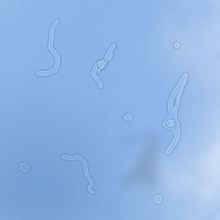User:Mr. Ibrahem/Floater
| Floaters | |
|---|---|
| Other names | Eye floaters, vitreous floaters, myodesopsia, myodaeopsia, myiodeopsia, myiodesopsia, muscae volitantes, mouches volantes |
 | |
| Simulated image of separated, unclumped floaters against a blue sky | |
| Specialty | Ophthalmology |
| Symptoms | Spots or lines that move across a person's vision[1] |
| Causes | Unknown, eye infection, injury, uveitis, vitreous detachment, retinal detachment[1][2] |
| Risk factors | Nearsighted, diabetes, and cataract surgery.[1] |
| Diagnostic method | Dilated eye exam[1] |
| Differential diagnosis | Migraine aura[3] |
| Treatment | Based on the underlying cause, often none[1] |
| Prognosis | Generally good[4] |
| Frequency | Common[1] |
Floaters are small dark spots or lines that slowly move across a person's vision.[1] They generally come and go and move with a person's eye.[1] They may become more noticeable when looking at a light colored surface.[1] Other symptoms that occur depend on the underlying cause.[2] Symptoms generally improve within 3 months.[4]
In most causes the cause is shrinkage of the vitreous due to an unknown reason, a posterior vitreous detachment.[2][4] Risk factors include being nearsighted, diabetes, and cataract surgery.[1] Other causes may include eye infection, injury, uveitis, vitreous detachment, or retinal detachment.[1] Diagnosis is by a dilated eye exam.[1]
Treatment depends on the cause; though in many causes nothing specific is required.[1] Occasionally in severe cases a type of surgery known as a vitrectomy may be suggested.[1] Repeated exams may be carried out to rule out a retinal tear or vitreous bleed.[4] Most people are affected at some point in time.[1] They become more common with age.[1]
References[edit]
- ^ a b c d e f g h i j k l m n o p "Floaters". NEI. Archived from the original on 21 December 2019. Retrieved 10 February 2022.
- ^ a b c "Floaters - Eye Disorders". Merck Manuals Professional Edition. Archived from the original on 30 October 2021. Retrieved 11 February 2022.
- ^ Johnson, D.; Hollands, H. (2011-11-28). "Acute-onset floaters and flashes". Canadian Medical Association Journal. 184 (4). Canadian Medical Association: 431. doi:10.1503/cmaj.110686. ISSN 0820-3946. PMC 3291672. PMID 22125334.
- ^ a b c d Bergstrom, Reece; Czyz, Craig N. (2022). "Vitreous Floaters". StatPearls. StatPearls Publishing. Archived from the original on 11 February 2022. Retrieved 11 February 2022.
